All of Wisconsin is in either “Moderate Potential” or “Highest Potential” risk for finding radon. Many Wisconsin counties, especially in the southwestern portion of the state, are in the “Highest Potential” area.
While carbon canisters are still a reliable testing method, we are now using electronic monitors. All short-term tests must remain a minimum of 48 hours to obtain an accurate result. The carbon canisters must then be sealed and mailed to a laboratory to determine the result. The process will often take a few days beyond the end of the canister retrieval. The electronic monitors produce a result as soon as the information is uploaded to the device software.
Radon testing is becoming more widely accepted in the Real Estate process. Wisconsin is considering joining the growing number of states that require radon testing as part of each home purchase.
Some believe testing radon levels in the basement, rather than on the first floor, will double the result. The EPA guidelines instruct device placement on the lowest level used in the home. Determining the lowest level being used can sometimes be difficult and is up to the judgement of the tester. While the result is generally higher in a basement, the result will often be less than 1 point higher.
Radon gas is present everywhere. The average outdoor level is .4 pCi/L (picocuries per liter) and the average indoor level is 1.3 pCi/L. While the EPA currently recommends action when the level gets above 4.0 pCi/L, no level of radon is considered completely safe so the recommendation is to keep the level as low as possible.
Information from the EPA:
Radon Myths and Facts
MYTH #1: Scientists are not sure that radon really is a problem.
FACT: Although some scientists dispute the precise number of deaths due to radon, all the major health organizations (like the Centers for Disease Control, the American Lung Association, and the American Medical Association) agree with estimates that radon causes thousands of preventable lung cancer deaths every year. This is especially true among smokers, since the risk to smokers is much greater than to non-smokers.
MYTH #2: Radon testing devices are not reliable and are difficult to find.
FACT: Reliable radon tests are available from qualified radon testers and companies. Active radon devices can continuously gather and periodically record radon levels to reveal any unusual swings in the radon level during the test. Reliable testing devices are also available by phone or mail-order, and can be purchased in hardware stores and other retail outlets. Contact your state radon office for a list of qualified radon test companies.
MYTH #3: Radon testing is difficult and time-consuming.
FACT: Radon testing is easy. You can test your home yourself or hire a qualified radon test company. Either approach takes only a small amount of time and effort.
MYTH #4: Homes with radon problems cannot be fixed.
FACT: There are solutions to radon problems in homes. Thousands of home owners have already lowered their radon levels. Most homes can be fixed for about the same cost as other common home repairs. Contact your state radon office for a list of qualified mitigation contractors.
MYTH #5: Radon only affects certain types of homes.
FACT: Radon can be a problem in all types of homes, including old homes, new homes, drafty homes, insulated homes, homes with basements, and homes without basements. Local geology, construction materials, and how the home was built are among the factors that can affect radon levels in homes.
MYTH #6: Radon is only a problem in certain parts of the country.
FACT: High radon levels have been found in every state. Radon problems do vary from area to area, but the only way to know a home’s radon level is to test.
MYTH #7: A neighbor’s test result is a good indication of whether your home has a radon problem.
FACT: It is not. Radon levels vary from home to home. The only way to know if your home has a radon problem is to test it.
MYTH #8: Everyone should test their water for radon.
FACT: While radon gets into some homes through the water, it is important to first test the air in the home for radon. If your water comes from a public water system that uses ground water, call your water supplier. If high radon levels are found and the home has a private well, call the Safe Drinking Water Hotline at (800) 426-4791 for information on testing your water. Also, call your state radon office for more information about radon in air.
MYTH #9: It is difficult to sell a home where radon problems have been discovered.
FACT: Where radon problems have been fixed, home sales have not been blocked. The added protection will be a good selling point.
MYTH #10: I have lived in my home for so long, it does not make sense to take action now.
FACT: You will reduce your risk of lung cancer when you reduce radon levels, even if you have lived with an elevated radon level for a long time.
MYTH#11: Short-term tests cannot be used for making a decision about whether to reduce the home’s high radon levels.
FACT: Short-term tests can be used to decide whether to reduce the home’s high radon levels. However, the closer the short-term testing result is to 4 pCi/L, the less certainty there is about whether the home’s year-round average is above or below that level. Keep in mind that radon levels below 4 pCi/L still pose some risk and that radon levels can be reduced to 2 pCi/L or below in most homes.
Please see basic information from the EPA by clicking on the link provided: Basic Radon Facts
The Wisconsin Department of Health Services reports 1 out of 10 Wisconsin homes has high radon levels.
https://www.dhs.wisconsin.gov/radon/index.htm
